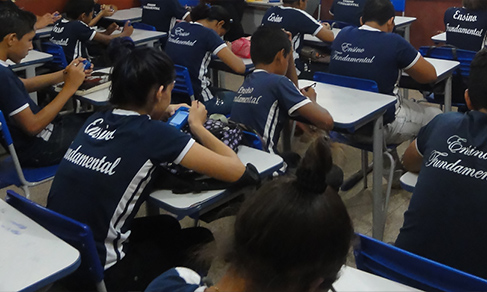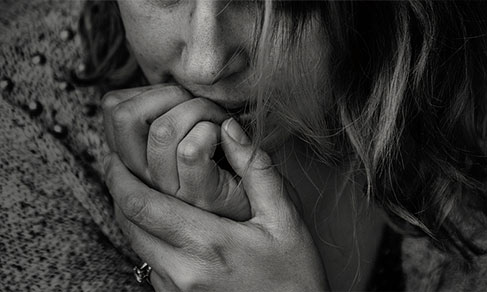Nossos serviços estão apresentando instabilidade no momento. Algumas informações podem não estar disponíveis.
PeNSE - National Survey of School Health
About - 2012
With this release, IBGE presents results of the National Survey of School Health, conducted in 2012, with students taking the 9th grade of elementary school in the country, as stated in a partnership established with the Ministry of Health. The survey, conducted in accordance with norms and guidelines applied at national and international level in studies involving human beings, and teenagers, especially, had as its main objective the identification and measurement of health risk factors and protection measures in this group, using as reference for the choice of sample the registry of public and private schools listed in the 2010 School Census, of the National Institute for Educational Studies and Research Anísio - INEP. A highlight in this survey is its wide geographic coverage, for it presents data relative to the country, its Major Regions, 26 state capitals and the Federal District.
This publication presents methodological procedures which have guided the elaboration of the survey, with special emphasis on the criteria used in the selection of the target-population, the sample plan and technical and ethical aspects related to data collection, and selected tables for each one of the topic investigated. The analysis of results, graphically illustrated, is intended to provide a profile of students' conditions in terms of each of the topics investigated, with highlight on the main facts observed. The publication also includes a glossary with essential concepts and definitions to the understanding of results.
The National Survey of School Health increases the knowledge about the characteristics of teenager population health conditions, providing executive and legislative powers, health councils and other related agents with reliable information for the guidance and evaluation of health policies directed to this important segment of Brazilian population.
Data released herein are also available on the CD-ROM which comes enclosed with the publication and on the IBGE web site, where they can also be seen though IBGEs Automatic Recovery System - SIDRA.
Main results - 2012
#seriehistorica201792153351540
#seriehistorica201792153552284
Tables - 2012
Tables
1 Characteristics of the school environment and surroundings
1.1 Information and communication structure (xls | ods)
1.3 Structure for physical activity (xls | ods)
1.4 Other characteristics (xls | ods)
2 Characteristics of the target population
2.2 Socioeconomic aspects (xls | ods)
2.3 Family context (xls | ods)
2.5 Physical activity practice (xls | ods)
2.6 Cigarette, alcohol and other drugs (xls | ods)
2.7 Sexual and reproductive health (xls | ods)
2.8 Violence, safety and accidents (xls | ods)
2.9 Hygiene habits (xls | ods)
2.11 Perception of body image (xls | ods)
2.12 Mental healthl (xls | ods)
2.13 Use of health service (xls | ods)
Concepts and methods - 2012
As informações a seguir descrevem os metadados estatísticos, que são o conjunto de conceitos, métodos e aspectos relacionados às estatísticas, e são informações necessárias para compreender as características e a qualidade das estatísticas e interpretá-las corretamente.
Informações Gerais
Objetivo
O objetivo da pesquisa é produzir informações que permitam conhecer a magnitude dos fatores de risco e proteção à saúde, orientar e avaliar as intervenções em saúde adequadas ao adolescente, contribuindo para o monitoramento da saúde do escolar. Com a edição de 2012, espera-se ampliar o conhecimento sobre a saúde dos adolescentes, e subsidiar as políticas públicas relativas a este grupo.Tipo de operação estatística
Pesquisa de estabelecimento de ensinoTipo de dados
Dados de pesquisa por amostragem probabilísticaPeriodicidade de divulgação
EventualPopulação-alvo
A população-alvo da pesquisa foi formada por escolares do 9º ano (antiga 8ª série) do ensino fundamental de escolas públicas e privadas.Metodologia
A amostra foi dimensionada de modo a estimar parâmetros populacionais (proporções ou prevalências) em diversos domínios geográficos: cada uma das 26 capitais dos estados da federação mais o Distrito Federal, o conjunto dessas capitais, cada uma das cinco grandes regiões geográficas do país (Norte, Nordeste, Sudeste, Sul e Centro-oeste), além do país como um todo.
O cadastro utilizado, para a seleção da amostra pesquisada, foi formado por 42,717 escolas de ensino fundamental listadas pelo Censo Escolar 2010, realizado pelo Instituto Nacional de Estudos e Pesquisas Educacionais Anísio Teixeira, do Ministério da Educação - INEP/MEC, que informaram possuir turmas de 9º ano do ensino fundamental nos seus turnos diurnos. Desse total, 7.519 estavam distribuídas pelas capitais dos estados e Distrito Federal e 35.198 localizavam-se nos demais municípios do país.
Os escolares foram selecionados a partir de dois planos amostrais distintos para os estratos geográficos dos municípios das capitais e para os cinco estratos geográficos formados pelos demais municípios.
As amostras dos estratos formados municípios das capitais foram obtidas em dois estágios. Primeiro foram selecionadas as escolas (unidades primárias de amostragem – UPA). Essas escolas foram visitadas para construção de uma lista atualizada de turmas de 9º ano, existentes em 2012. A partir da obtenção dessas listas, foram selecionadas as turmas (unidades secundárias de amostragem – USA).
Para estratos geográficos formados pelos demais municípios, a seleção foi em três estágios. No primeiro estágio, foram selecionados grupos de municípios (unidades primárias de amostragem – UPA); no segundo estágio, foram selecionadas escolas (unidades secundárias de amostragem – USA); e, no terceiro estágio, as turmas (unidades terciárias de amostragem – UTA) cujos alunos formaram a amostra de estudantes de cada estrato. Os municípios foram agrupados seguindo critérios de homogeneidade e vizinhança, obtendo-se grupos de 300 a 600 turmas aproximadamente. Em seguida, selecionada uma amostra desses grupos em cada Grande Região, de onde foram selecionadas as escolas (USA) que fariam parte da amostra.
Em ambos os casos, foi selecionada, aleatoriamente e com probabilidades iguais, uma turma em cada escola selecionada que tivesse uma ou duas turmas de 9º ano do ensino fundamental, e duas turmas em cada escola com três ou mais turmas desses escolares. Em cada uma das turmas selecionadas, todos os alunos foram convidados a responder o questionário da pesquisa.
O tamanho da amostra em cada estrato foi calculado para fornecer estimativas de proporções (ou prevalências) de algumas características de interesse, em cada um dos estratos geográficos, com um erro máximo aproximado de 3% em valor absoluto ao nível de confiança de 95%.
Foram entrevistados 109.104 escolares em 2.842 escolas. Do total de escolas selecionadas, 162 não foram pesquisadas por diversos motivos, dentre eles cinco recusas por parte da direção.
A pesquisa foi realizada utilizando microcomputador de mão, Personal Digital Assistant (PDA). Para os estudantes, foi inserido o questionário estruturado, autoaplicável, com módulos temáticos que variavam em número de perguntas. A PeNSE 2012 introduziu um segundo questionário, referente ao ambiente escolar, aplicado ao diretor ou responsável pela escola e preenchido pelo agente de coleta do IBGE, incluindo temas sobre estrutura da escola, dimensão, espaços, equipamentos, práticas, políticas e situações do entorno.
A antropometria não foi realizada em 2012.
Técnica de coleta:
CASI - Questionário eletrônico autopreenchido, CAPI - Entrevista pessoal assistida por computadorTemas
Temas e subtemas
Grupos populacionais específicos, População, Educação, Saúde, Justiça e segurançaPrincipais variáveis
QUESTIONÁRIO DO ALUNO-Escolaridade dos pais
- Trabalho entre escolares
- Posse de bens e serviços
- Conhecimento dos pais ou responsáveis acerca do tempo livre dos escolares
- Falta às aulas sem permissão dos pais ou responsáveis
- Entendimento dos pais ou responsáveis quanto aos problemas e preocupações dos filhos
- Consumo de alimentos marcadores de alimentação saudável
- Consumo de alimentos marcadores de alimentação não saudável
- Atividade física globalmente estimada
- Hábito sedentário: tempo assistindo TV
- Uso de cigarro e outros produtos do tabaco
- Experimentação precoce de bebidas alcoólicas
- Uso de drogas ilícitas alguma vez na vida
- Iniciação sexual
- Uso de preservativos
- Segurança no trajeto casa-escola e no espaço escolar
- Violência no trânsito
- Bullying
- Lavar as mãos
- Frequência de ida ao dentista
- Atitude em relação ao peso corporal
- Sentimento de solidão
- Uso de serviços de saúde
- Prevalência de asma
QUESTIONÁRIO DA ESCOLA
- Características do ambiente escolar e entorno.
- Estrutura de informação e comunicação
- Alimentos comercializados
- Estrutura para atividades físicas
- Atividades e políticas (conselho escolar, atividade extraclasse, ambientes livres de tabaco)
- Aspectos de localização da escola quanto a risco de violências.
Unidades de informação
Unidade de investigação
Pessoa, EstabelecimentoUnidade de análise
Pessoa, Estabelecimento.Períodos de referência
Data de início da coleta
15/04/2012Data do fim da coleta
15/09/2012Disseminação
Formas de disseminação
Publicação Digital (online), Publicação impressa com CD-ROMNível de desagregação geográfica
Grandes RegiõesNível de divulgação
Os resultados foram divulgados para Brasil, Grandes Regiões, municípios das capitais e o Distrito Federal.Instrumentos de coleta
Histórico
A segunda edição da PeNSE foi realizada em 2012, a partir de convênio celebrado entre o IBGE e o Ministério da Saúde - MS, com o apoio do Ministério da Educação - MEC.
Saiba mais
https://metadados.ibge.gov.br/consulta/estatisticos/operacoes-estatisticas/AAPublications - 2012
Pesquisa nacional de saúde do escolar : 2012
Material type: Book
Year: 2013
Description
The Brazilian Institute of Geography and Statistics - IBGE - carries out the National Survey of School Health (PeNSE), in several cities in Brazil, in partnership with the Ministry of Health and with the support of the Ministry of Education.
The research goals are:
- to get to know and measure risk and protection factors concerning teenagers' health.
- to support the monitoring of Brazilian students' health.
- to offer guidance to health initiatives aimed at this population group by providing reliable information on the subject.
Time series
#seriehistorica201792151245656
#seriehistorica201792151426267
#seriehistorica201792151529808
#seriehistorica201792151631235
#seriehistorica201791163536744
#seriehistorica201792152311516
.
Microdata
Microdata Files of PeNSE 2015 - updated on May 25, 2018
Updating
- May 25, 2018: The updating are related to:
1- Inclusion of the document "Methodological note no. 01: Information for the use of microdata - Samples 1 and 2", which includes guidelines for the use of the data of PeNSE 2015, in the "Technical information" section.
1- Inclusion of the document "Methodological note no. 02: Specification of tables and indicators - Sample 1", which includes the filters used to build the tables of the Sample 1 made available in the publication and on the PeNSE 2015 web page, in the "Technical information" section.
1- Inclusion of the document "Methodological note no. 03: Specification of tables and indicators - Sample 2", which includes the filters used to build the tables of the Sample 2, in the "Technical information" section.
4- Inclusion of the folder “PeNSE_2015_AMOSTRA1.zip” containing the microdata of Sample 1 in the “.csv”, “.sas” and “.xlsx” formats, as well as of the file “Dicionario_PENSE_Microdados_Amostra1.xls” in place of the file “Dicionario_PENSE_Microdados.xls”. The new file contains two tabs (“AMOSTRA1_ALUNO” and “AMOSTRA1_ESCOLA”) with the description of the variables associated with requirements of the questionnaires applied to the students and schools selected for Sample 1. In addition to the file previously made available:
4.1- The description "Non applicable" attributed to the code "-1" was replaced by "Jump in the questionnaire".
4.2- Amendment of the coding of the answer options attributed to variable “V008 – Administrative sphere of the school” (previously coded as “1 – Municipal; 2 – State; 3 – Federal; 4 – Private”): in the document now made available, the coding is “1 – Federal; 2 – State; 3 – Municipal; 4 – Private”.
5- Inclusion of the folder “PeNSE_2015_AMOSTRA2.zip” containing the microdata of Sample 2 in the “.csv”, “.sas” e “.xlsx” formats, as well as of the file “Dicionario_PENSE_Microdados_Amostra2.xls”, which contains two tabs (“AMOSTRA2_ALUNO” and “AMOSTRA2_ESCOLA”) with the description of the variables associated with questionnaire items applied to the students and schools selected for Sample 2. - May 5, 2017: The updating are related to:
1- Exclusion of the variable EXTRATO_EXP_CHAR from the files "PENSE_AMOSTRA2.csv", "pense_amostra2.sas7bat", and "PENSE_2015_Microdados.v3.xlsx", as it is the same variable as EXTRATO_EXP.
2- Inclusion of the variable school, which corresponds to the primary sampling unit - UPA in the files "PENSE_AMOSTRA2.csv", "pense_amostra2.sas7bat" and "PENSE_2015_Microdados.v3.xlsx".
3- Amendment of the variable school in the AMOSTRA1_ALUNO and AMOSTRA1_ESCOLA tabs of the file "Dicionário_PENSE_Microdados.xls", whose description became an UPA.
4- Inclusion of the variable school in the AMOSTRA2 tab of the file "Dicionário_PENSE_Microdados.xls", whose description is an UPA.
- September 2, 2016: Stratum variables were added, used in the expansion.
- September 2, 2016: The micro data became also available in XLSX format.
Technical Information
Methodological considerations on the National Survey of School Health - PeNSE can be obtained in the Technical notes chapter of its results publication.
Additional methodological notes on the 2015 edition
- Methodological note 01 - Informatio for the use of microdata - Samples 1 and 2
- Methodological note 02 - Specifications of tables and indicators - Sample 1
- Methodological note 03 - Specifications of tables and indicators - Sample 2
News and Releases
IBGE survey shows a decade of information on students’ health
A decade of surveys about teenage health and its tendencies. That is what the IBGE has released today...
13/07/2022
2019 PeNSE: one out of every five female students has suffered sexual violence
Nearly 14.6% of students aged 13 and 17, has, at some point in their lives and against their will, been...
10/09/2021
One of every five school girls has suffered sexual violence
Sexual violence is present in the lives of a significant percentage of boys and girls who attend school....
10/09/2021
Six of every ten students had tried alcoholic drinks in the pre-pandemic period
Nearly 63.3% of students from public and private schools aged 13 to 17 have already tried alcoholic drinks...
10/09/2021
A matter of gender: mental health indicators are worse for girls
Girls, most of the time, have been feeling sadder than boys. And also more worried or feeling that nobody...
10/09/2021
Study defines Brazilian students' health conditions and habits
Non-communicable chronic degenerative diseases, which are responsible for 72% of deaths in the world,...
08/04/2019
Errata
Correction of the codification of answers to variable “V008 – Administrative sphere of the school” in the data dictionary of PeNSE 2015
Published date: 25/05/2018
Description:
The error resulted from a failure in the typing of possible answers to variable “V008 – Administrative sphere of the school” in the data dictionary of PeNSE 2015. The inversion of categories “1 – Municipal” and “3 – Federal” generated incorrect results for "Administrative sphere of the school". The variable, previously codified as “1 – Municipal; 2 – State; 3 – Federal; 4 – Private”, was changed into: “1 – Federal; 2 – State; 3 – Municipal; 4 – Private”.
Actions: Correction of the codification of the possible answers to to variable “V008 – Administrative sphere of the school” in the data dictionary of Pense 2015.









